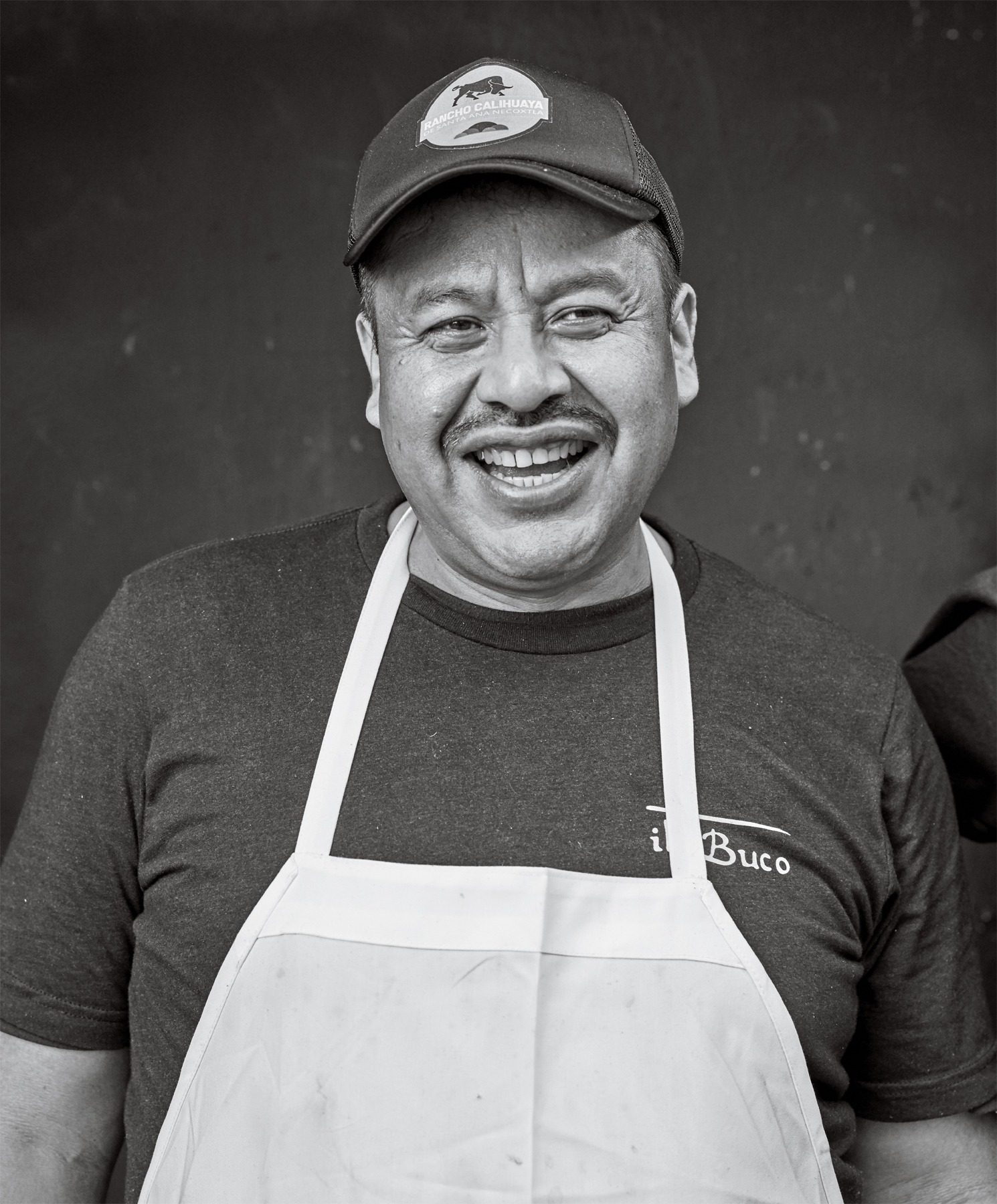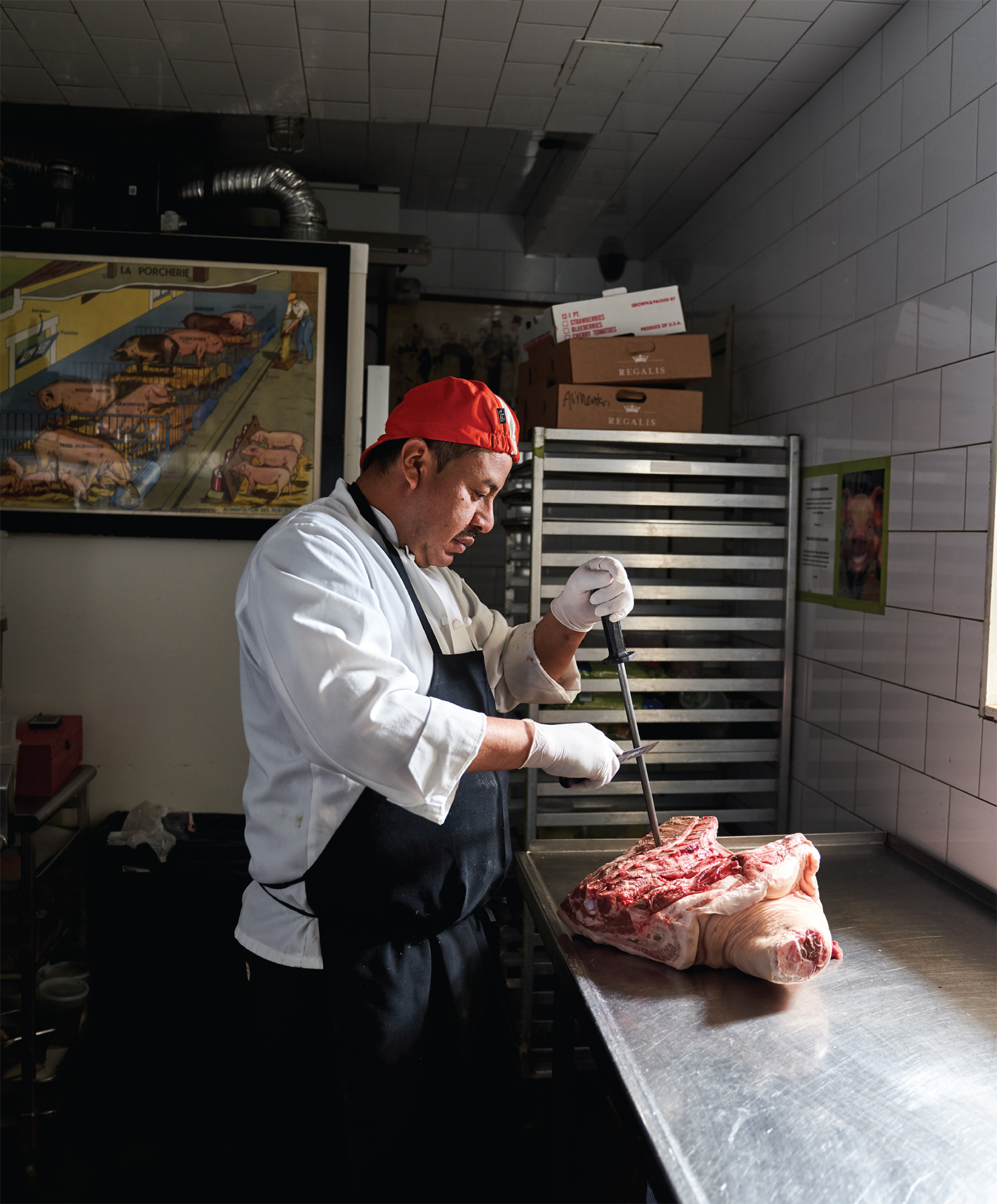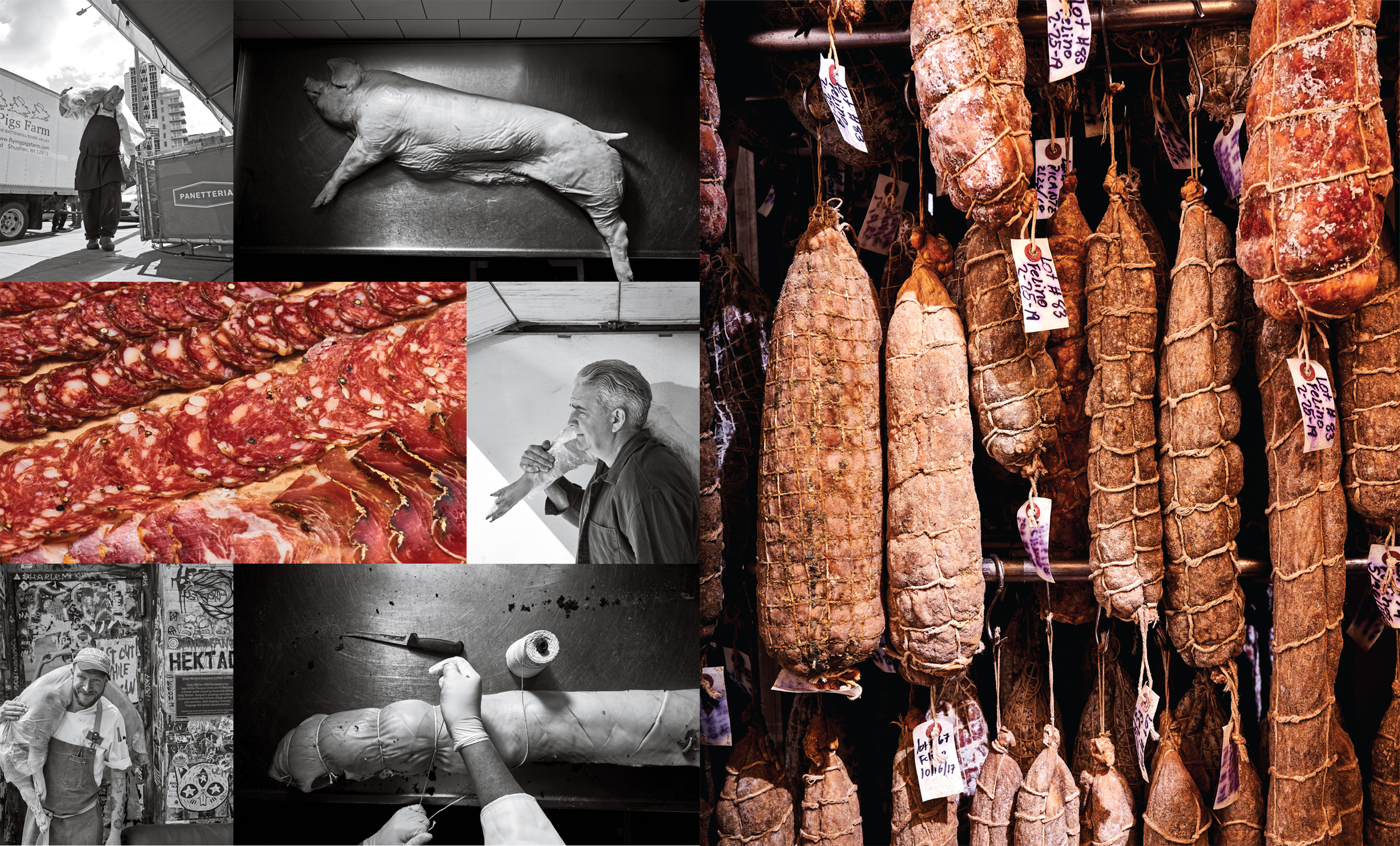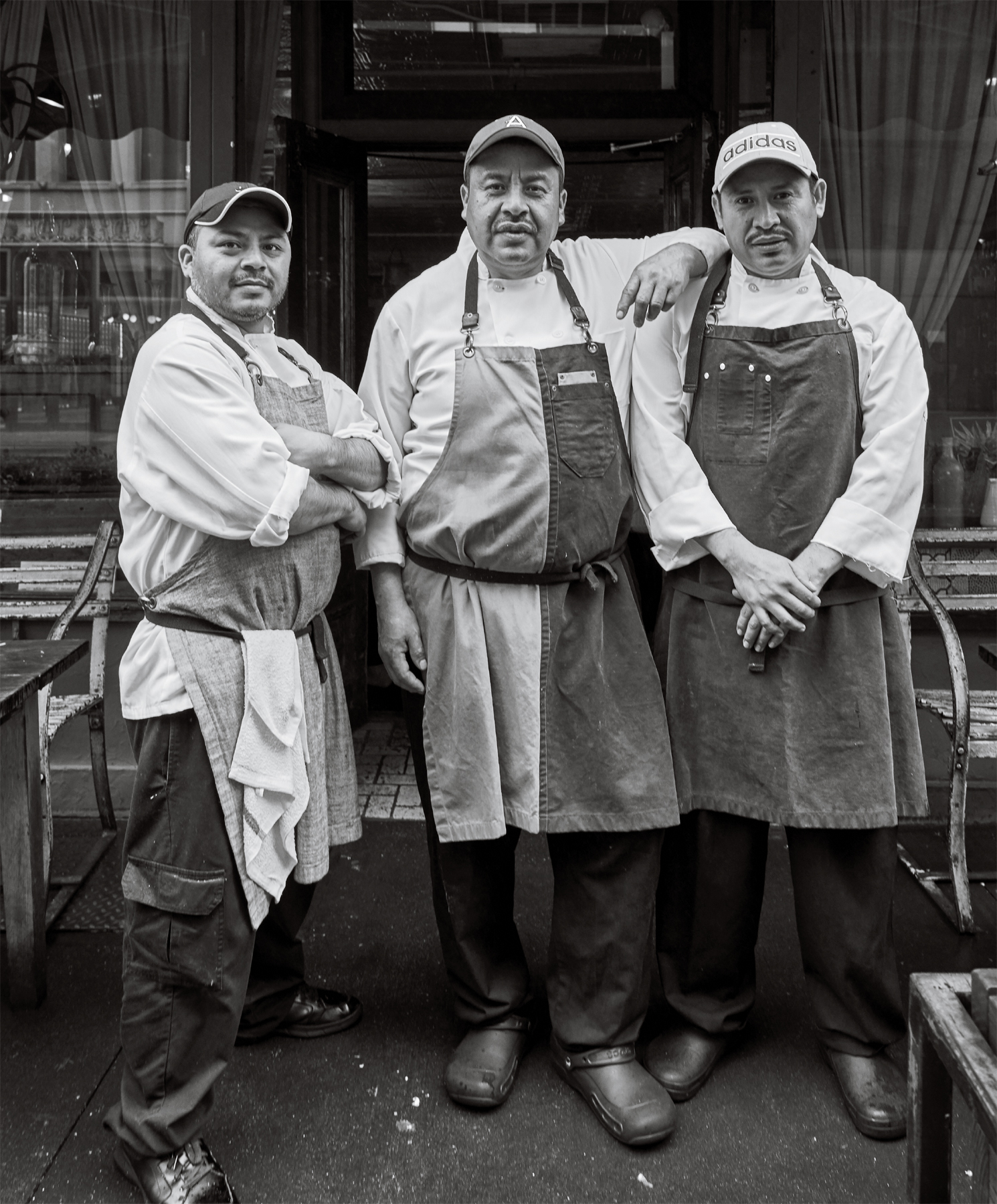
House cured guanciale, il Buco Alimentari
XII
SALUMI
At its heart, an alimentari is a place you go to be nourished. All across Italy, in cities, towns, and villages, you’ll find these usually mom-and-pop-owned places that do business selling grocery items and simple sandwiches, everything from apples to Kinder eggs to crusty loaves of ciabatta. And it’s not an uncommon—but always a very welcome—sight to see, hanging above the delicatessen counters and displayed within them, an array of dried and cured meats—what we call salumi—in various shapes and sizes.
To a newcomer, the sheer variety can be daunting. Some salumi look like classic sausages, link upon link upon link. Some, oddly shaped and wrapped in cheesecloth, are totally unidentifiable. And some, like the venerated prosciutto di Parma, made of the entire hind leg of a pig, are perhaps a little too identifiable. There they hang, festooned like prayer flags in the store, announcing that this is a place that will satisfy your hunger. Not every alimentari in Italy—and actually fewer and fewer—makes their own salumi in-house. It’s a costly and time-consuming process. But when we opened il Buco Alimentari e Vineria in 2011, salumi was at the center of the project. In fact, it was the very reason we opened at all.
The planning for Alimentari began in earnest on one of the darkest days of Bernardo Flores’s life back in 2006. Today, Bernardo is our salumi master or salumiere. Good natured, shy, watchful, a man who keeps his passions cloaked under his hooded eyelids, Bernardo has been with me from nearly the beginning. He arrived in our kitchen twenty years ago, shortly after coming to New York from Puebla, Mexico. He started as a dishwasher, but he was a hard worker and a dependable presence, and soon he worked his way up our loose kitchen hierarchy from dishwasher to salad man to cook.
At the time, Alberto—who can and does go on for hours about the magic of cured meat—was already trying to build our salumi program from the ground up. Like many Italians, especially those from poor rural areas, salumi wasn’t a luxury for Alberto or his family growing up. It was a necessity, a way to keep a hog feeding a family for months or even years. Think of Roberto, whose room in the basement of his childhood home stood in as a curing room for the family salumi. If you ask him why he no longer eats pork, he’ll tell you of the time he discovered that the salumi hanging from the rafters had been made from his beloved pet pig. Similarly, our first attempt at salumi was a distinctly DIY effort. Alberto invited his friends Salvatore and Efisio, butchers from his hometown of Foligno, to get us started. During lulls in service, Bernardo went downstairs to watch.
He noted how the men broke down half hogs, delivered to us from our friend Mike Yezzi at Flying Pigs Farm in Battenkill Valley. He saw how they separated the animal into its primal cuts and how, unlike American butchers, Salvatore and Efisio cut along the animal’s natural seams, preserving the long muscles of the back, belly, leg, and shoulder for curing. And how they extracted from these almost sculptural forms, pink girded in white fat, the meat that would become, in months’ time, lonzas, coppas, culatellos, pancettas, prosciuttos, and more. He watched as they coated the meat in salt and let it sit, allowing the crystals to draw out the moisture from the meat itself over time, until it was ready to be hung and, largely, left for up to a year.
One day Alberto, noting how rapt Bernardo was, said, “Bernardo, you aren’t going back to the kitchen. You’re going to stay here with us and learn.” And so began his education. Gradually, Bernardo learned how to wield the long skinny knives for separating fat from meat. He learned to cut at the joints. He learned that the long loin running along the pig’s back is the lonza and the belly is the pancetta and the cheek becomes guanciale and the leg becomes prosciutto or, perhaps, the most rarefied of all salumi, the culatello. Most important, he learned about the alchemical power of salt and time. Back then, we were making mostly prosciutto. It is a large cut and it takes the most time to cure, which means, if done right, the flavors become complex, the meat almost crystallized with nutty overtones, while the fat remains buttery, beautiful silky white.
By the time Salvatore and Efisio returned to Italy a few months later, Bernardo had fully embraced his calling as a salumiere. In a nook of the wine cellar enclosed by glass hung the fruits of his, Salvatore’s, and Efisio’s work: neat lines of hanging inchoate prosciutto. For a time after they left, Bernardo was happy to continue the tradition as he learned it from them. But he’s also a wonderfully curious spirit, and soon he began to experiment too. The process of salumi is at once incredibly simple and very complex. Like any fermentation process from beer to bread, curing meat relies on the natural environment. It is the job of the salumiere to create the correct conditions for the microorganisms to do their work. Salt, time, and meat is all you need, but how much of each you use and how skillfully you use it determines whether the end product will be delicious or, potentially, deadly—a host of deleterious bacteria, from listeria to botulism to salmonella, as well as harmful molds can grow in the whole cuts as well as the ground meat preparations. So Bernardo strictly hewed to temperature and storage controls, as well as adding the minimal amount of sodium nitrates and nitrites to prevent the growth of certain microbes like botulism.
Over the course of a few years, Bernardo perfected his craft, learning to carefully weigh the meat and salt accordingly. He experimented with how much fennel to add in the finocchiona, what type of chili to add to our spicy salami toscano, and how much salt to use for his prosciutto. Because salumi relies on time, these changes were borne out only months later. Alberto and I, as well as the rest of our diners, were impressed with the results. Our salumi board was one of the best sellers at il Buco. We were, as they say, riding high on the hog.

Bernardo Flores, salumiere

Bernardo processing a pig
We would continue to develop our program over time. In 2003, my dear friend, food writer Peter Kaminsky—who had written his first Underground Gourmet piece on il Buco in 1994—invited me to tag along on a trip to a Land Stewardship and Sustainability Conference in South Carolina. Peter was involved in a project rescuing a strain of Spanish pigs left on an island off the coast of Georgia called the Ossobaw. We visited two farmers who were raising these hogs on acorns and peanuts to follow in the footsteps of the Spanish Iberico producers, creating a fat content high in oleic acids and much healthier for the consumer. The meat was sweet and delicious. We began working with these farmers to cure this meat with great results.
Then one day, everything went sideways. It was in the spring of 2006. The health inspector made an unannounced visit to il Buco and our unsanctioned salumi facility downstairs. Though we were as rigorous as we could be, obviously we were not up to code. Bernardo had meticulously followed safety guidelines to ensure that his salumi had the proper pH and water content, but we had not filed an HACCP plan—the small mountain of paperwork that we would have needed to complete to be legit. At the time, and even now, salumi and the health department eye each other warily. What’s more, salumiere necessarily introduce bacteria to their protein and let it flourish in order to properly cure the meat in the absence of traditional cooking methods. Nothing could be more abhorrent in the risk-averse black-and-white eyes of the law.
When Bernardo reported the next morning for work, he came across a massive pile of his beloved prosciutto and salumi on the curb of Bond Street. At first he thought it was a terrible mistake, that perhaps someone mistook these darkened shapes for trash. He rushed to rescue them. But upon approaching the pile, he smelled the piercing aroma of bleach. The inspectors had instructed our staff to cut up the meat and douse it in bleach to render it inedible. This pile represented for Bernardo not just years of work and experimentation at il Buco but also the dream that a kid from Puebla, Mexico, could through the sheer force of work and drive become a legitimate Italian salumiere in New York City. He was, of course, heartbroken.
Losing the prosciutto and the rest of the salumi that morning, and seeing how hard hit Bernardo was, I vowed to one day find a way to restore our wonderful salumi program legitimately. This was one of the primary motivations for opening Alimentari. It would be six years and many misses before we happened upon the lumberyard on Great Jones Street. But this time, I resolved we would do it right. We would follow every rule to the T.
But we needed help, someone who was a professional salumiere. So I called Christopher Lee, who had worked with my friend Alice Waters at Chez Panisse for sixteen years. Chris was the one who started their meat-curing program. He was living in Berkeley at the time. The challenge of restarting a salumi program, and the possibility of building it literally from the ground up, was appealing to him. He brought us a sample of his own home-cured prosciutto and we were immediately sold.
Chris showed up with an enormous amount of patience, detailed knowledge of bureaucracy, and a folio full of recipes. He was one of the first salumi masters in the United States and had frequently traveled to Italy to learn from the masters there, like Francois Vecchio and Dario Cecchini. Over time, he and Bernardo worked together to standardize and professionalize the program at il Buco and planned for what they would build at Alimentari. State of the art curing boxes were brought in from Umbria under Alberto’s guidance, and the space was taking shape.

CLOCKWISE FROM TOP LEFT: Pig delivery; pig from Flying Pigs Farm; hanging house-cured salumi; tying off the porchetta; Alimentari Chef Preston Madson; salumi platter, il Buco Alimentari; Mike Yezzi, Flying Pigs Farm

Angel, Bernardo, and Marcelo Flores
Because it was so central an element to our project, I was adamant that we open with salumi already made. This, of course, presented a whole range of logistical challenges for the team. A prosciutto, for instance, takes a minimum of fourteen months of aging. Fourteen months before we opened il Buco Alimentari, it was still very much a construction site. Luckily, Chris convinced his friend Bev Eggleston in Virginia to “host” some of our early efforts. As we got closer to opening, Chris and Bernardo spent day and night breaking down hogs and turning them into various salumi and salame. Inside a pristine butchering room, they worked in almost balletic harmony, deftly wielding their knives and wasting nothing. They carefully weighed and salted the muscles to what would become the whole muscle cuts. They added the herbs and mixed what would eventually become sausage. Then onto a rack and into a quiet dark room the meat went, to age for months to come. When we finally opened our doors in September, not only was I proud to have our own salumi in the case, but I was happy to know that in our basement there was a completely HACCP-certified facility, full of aging salumi.
Chris helmed the opening of the market and worked hand in hand with Bernardo until 2013 when he returned to California, leaving Bernardo to lead our program. The salumi received accolades from clients and friends in the industry alike from day one and has been the highlight of the market. The salumi plate is still one of the most popular things on the menu at both il Buco and at Alimentari. Bernardo, meanwhile, has grown too. His kids, babies when I first met them, have grown up and gone on to college. (His son graduated with a degree in criminal justice. His daughter is a pediatrician.) His nephews and extended Flores family members—Angel, Pancho, Marcelo—have been working with him for years at il Buco, each lending his craft and dedication to our team. Over the years, Bernardo has truly become a master salumiere.
Often, on my frequent trips to Italy, the birthplace of salumi, I’ll find myself missing Bernardo’s salumi on Great Jones Street and the deep sense of nourishment I get every time I walk into Alimentari.